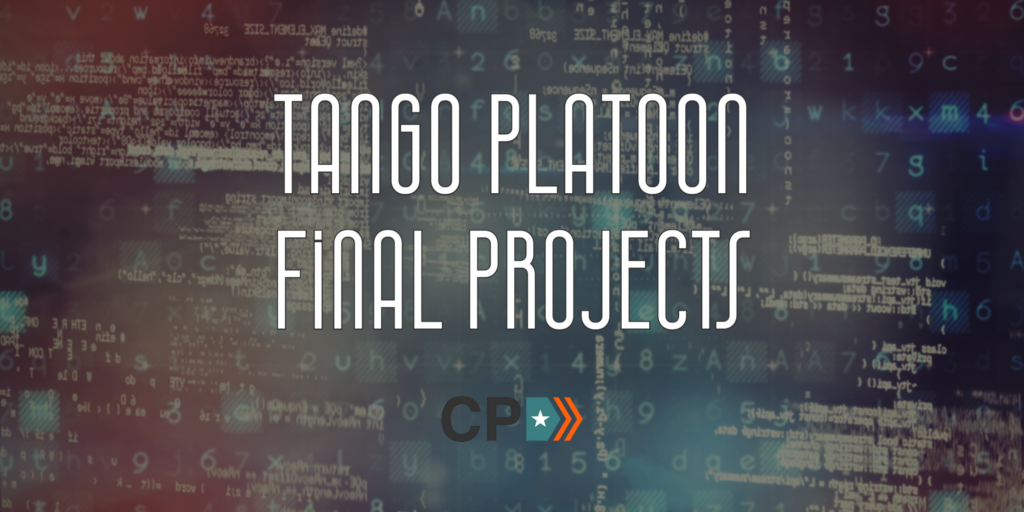The article titled “DevOps Alpha Platoon Final Projects” highlights the culmination of the DevOps and Cloud Engineering program at Code Platoon. This piece focuses on the final projects that the participants in the program have completed, showcasing their expertise and technical skills. The article aims to provide insight into the program and the successful outcomes achieved by the participants, further emphasizing the value and effectiveness of the Code Platoon curriculum.
Introduction to the DevOps Alpha Platoon
Overview of the DevOps Alpha Platoon
The DevOps Alpha Platoon is a specialized training program designed to equip participants with the skills and knowledge necessary for success in the field of DevOps and Cloud Engineering. It is a rigorous program that combines classroom instruction, hands-on projects, and real-world experience to ensure that participants are fully prepared for the challenges they will face in the industry.
Background of the Participants
The participants in the DevOps Alpha Platoon come from a variety of backgrounds, including veterans and spouses of servicemembers. They are individuals who are eager to transition into the technology field and are committed to developing their skills in DevOps and Cloud Engineering. Many of them have prior experience in related fields, such as software development or IT support, which provides a strong foundation for their training.
Training and Skill Development
The training provided in the DevOps Alpha Platoon is comprehensive and intensive. Participants learn the latest industry best practices, tools, and technologies through a combination of lectures, workshops, and hands-on projects. They also have the opportunity to work on real-world projects, allowing them to apply their knowledge and develop practical skills. Throughout the program, participants receive mentorship and guidance from experienced professionals in the field, ensuring that they are well-prepared for their future careers in DevOps and Cloud Engineering.
Purpose of the Final Projects
Demonstration of Skills
The final projects in the DevOps Alpha Platoon serve as a culmination of the participants’ training and provide an opportunity for them to showcase the skills and knowledge they have acquired throughout the program. These projects are designed to be challenging and complex, requiring participants to integrate various DevOps principles and practices to develop innovative solutions for real-world problems.
Real-World Application
The final projects in the DevOps Alpha Platoon are not just theoretical exercises; they are meant to have a real-world impact. Participants are encouraged to identify relevant industry problems and develop solutions that can be implemented in a practical setting. By working on these projects, participants gain hands-on experience in applying their skills to solve real-world challenges, which enhances their understanding of the DevOps and Cloud Engineering field.
Feedback and Evaluation
The final projects in the DevOps Alpha Platoon also serve as a means for participants to receive feedback and evaluation from industry experts. This feedback is crucial in helping participants identify areas for improvement and further refine their skills. It also provides an opportunity for participants to engage with professionals in the field and build valuable connections that can benefit them in their future careers.

Project 1: Deployment Automation
Overview of Deployment Automation
Deployment automation is a critical aspect of DevOps and involves the process of automating the deployment of software applications to various environments. This includes tasks such as configuring servers, creating databases, and deploying the application code. By automating these tasks, organizations can streamline their deployment processes, reduce errors, and increase efficiency.
Tools and Technologies Used
In the Deployment Automation project, participants utilize a variety of tools and technologies to automate the deployment process. This may include tools such as Jenkins, Ansible, Docker, and Kubernetes, which are commonly used in the industry for automating deployment tasks. Participants also learn about infrastructure-as-code principles, which involves writing code to define and manage infrastructure resources.
Challenges and Solutions
Throughout the Deployment Automation project, participants face various challenges, such as configuring complex environments, managing dependencies, and handling version control. These challenges require creative problem-solving and collaboration among team members. Participants leverage their training and the support of their mentors to identify solutions and implement them effectively.
Result and Impact
The Deployment Automation project results in an automated deployment process that is efficient, reliable, and scalable. By automating the deployment process, organizations can significantly reduce the time and effort required to deploy software applications. This allows for faster and more frequent deployments, which enables organizations to deliver new features and updates to users more quickly. Additionally, the automated deployment process reduces the risk of human error, resulting in more stable and reliable software releases.
Project 2: Continuous Integration and Delivery
Explanation of Continuous Integration and Delivery
Continuous Integration and Delivery (CI/CD) is a set of practices and principles that enable organizations to deliver software updates and enhancements more frequently and reliably. It involves automating the process of merging code changes, building and testing applications, and deploying them to production environments. CI/CD helps organizations achieve faster time-to-market, reduce development costs, and improve overall quality.
Implementation Process
In the Continuous Integration and Delivery project, participants learn how to implement CI/CD pipelines using industry-standard tools and technologies. This includes setting up automated build and test environments, configuring version control systems, and creating deployment pipelines. Participants gain hands-on experience in configuring and managing tools such as Git, Jenkins, and AWS CodePipeline.
Benefits and Challenges
Implementing CI/CD pipelines offers several benefits, such as reducing the time and effort required for manual testing and deployment, improving collaboration and communication among development teams, and increasing overall software quality. However, implementing CI/CD also presents challenges, such as managing complex build and test configurations, ensuring compatibility across different environments, and maintaining the stability of production systems.
Evaluation and Improvement
Throughout the Continuous Integration and Delivery project, participants continually evaluate and improve their CI/CD pipelines based on feedback and metrics. They leverage tools such as SonarQube for code quality analysis, performance testing tools for load testing, and monitoring tools for tracking the performance and reliability of the CI/CD pipelines. This feedback-driven approach allows participants to identify and address bottlenecks and improve the overall efficiency and effectiveness of their CI/CD processes.

Project 3: Infrastructure as Code
Introduction to Infrastructure as Code
Infrastructure as Code (IaC) is a practice that involves managing and provisioning infrastructure resources using code. It allows organizations to define, configure, and manage their infrastructure resources in a consistent and automated manner, ensuring reproducibility and scalability. IaC replaces manual and error-prone processes with automated and version-controlled code, improving efficiency and reducing the risk of configuration drift.
Tools and Frameworks Utilized
In the Infrastructure as Code project, participants learn and utilize tools and frameworks such as Terraform, AWS CloudFormation, and Ansible. These tools provide a declarative and programmatic approach to managing infrastructure resources, allowing participants to define and provision resources such as virtual machines, networks, and storage in a repeatable and scalable manner.
Advantages and Limitations
Implementing Infrastructure as Code offers several advantages, such as faster and more consistent provisioning of resources, reduced risk of human error, and improved scalability and manageability. However, there are also limitations to consider, such as the learning curve associated with using new tools and technologies, the need for proper testing and validation of infrastructure changes, and the potential for automation-related issues to impact critical systems.
Success Metrics
Throughout the Infrastructure as Code project, participants define and track success metrics to measure the effectiveness and impact of their infrastructure automation efforts. These metrics may include factors such as reduced infrastructure provisioning time, increased resource utilization, improved deployment success rates, and improved infrastructure reliability. By monitoring and analyzing these metrics, participants can identify areas for improvement and optimize their infrastructure automation processes.
Project 4: Monitoring and Logging
Importance of Monitoring and Logging
Monitoring and logging are critical components of any DevOps system. They provide insights into the performance, availability, and security of applications and infrastructure. Effective monitoring and logging practices enable organizations to proactively identify and address issues, ensure system reliability, and optimize resource utilization.
Typical Monitoring and Logging Solutions
In the Monitoring and Logging project, participants learn about different monitoring and logging solutions and how to implement them effectively. They explore tools and platforms such as Prometheus, Grafana, ELK stack (Elasticsearch, Logstash, Kibana), and AWS CloudWatch. By leveraging these tools, participants can monitor various aspects of their applications, infrastructure, and logs, and gain actionable insights.
Integration with DevOps Processes
Monitoring and logging must be seamlessly integrated with other DevOps processes to be effective. Participants in the Monitoring and Logging project learn how to incorporate monitoring and logging into their CI/CD pipelines, deployment processes, and incident response workflows. This integration ensures that monitoring and logging are an integral part of the development and operation of applications and infrastructure.
Lessons Learned and Best Practices
Throughout the Monitoring and Logging project, participants gain valuable experience in setting up and configuring monitoring and logging systems. They learn about common challenges, such as identifying relevant metrics, setting up efficient alerting mechanisms, and managing log volumes. By sharing their lessons learned and best practices, participants contribute to the collective knowledge of the DevOps Alpha Platoon community and help others improve their monitoring and logging capabilities.

Project 5: Security and Compliance
Significance of Security and Compliance in DevOps
In the DevOps Alpha Platoon, participants learn about the importance of security and compliance in the context of DevOps and cloud engineering. They understand that security breaches can have significant financial, reputational, and legal consequences for organizations. As a result, security and compliance practices must be integrated into every aspect of DevOps processes to ensure the confidentiality, integrity, and availability of applications and infrastructure.
Implementation of Security Measures
The Security and Compliance project focuses on implementing effective security measures in the DevOps workflow. Participants learn about best practices in areas such as access management, vulnerability management, and secure coding. They gain hands-on experience in implementing security controls, such as multi-factor authentication, intrusion detection systems, and secure coding practices.
Compliance Requirements and Standards
In addition to security practices, participants also learn about compliance requirements and standards, such as the General Data Protection Regulation (GDPR), Payment Card Industry Data Security Standard (PCI DSS), and Health Insurance Portability and Accountability Act (HIPAA). They understand the importance of adhering to these regulations and develop strategies for ensuring compliance within their DevOps processes.
Continuous Improvement and Updates
Security and compliance are ongoing efforts that require regular updates and improvements. Participants in the Security and Compliance project learn about the importance of continuous monitoring, vulnerability scanning, and threat intelligence gathering. They also explore strategies for responding to and mitigating security incidents effectively. By embracing a culture of continuous improvement, participants can ensure that their DevOps processes remain secure and compliant with industry standards.
Project 6: Cloud Migration
Overview of Cloud Migration
Cloud migration is the process of transitioning an organization’s applications and infrastructure from on-premises environments to cloud environments. Cloud migration offers several benefits, such as scalability, cost-effectiveness, and improved accessibility. However, it also presents challenges, such as data migration, application compatibility, and security considerations.
Planning and Preparation Phase
In the Cloud Migration project, participants learn about the planning and preparation phase of a cloud migration project. They gain an understanding of the various factors that need to be considered, such as selecting the appropriate cloud service provider, assessing the readiness of applications for migration, and developing migration plans that minimize downtime and data loss.
Execution and Migration Process
Participants also learn about the execution and migration process itself. They gain hands-on experience in performing data migration, replicating virtual machines, and reconfiguring network settings in the cloud environment. By leveraging automation tools and following best practices, participants ensure a smooth and successful migration.
Benefits and Challenges
Cloud migration offers several benefits, such as reduced infrastructure costs, increased scalability, and easier resource management. However, it also presents challenges, such as application refactoring, ensuring data security and compliance, and managing cloud costs effectively. Participants in the Cloud Migration project gain insights into these challenges and explore strategies for overcoming them.

Project 9: Collaboration and Communication Tools
Importance of Collaboration and Communication in DevOps
Effective collaboration and communication are essential for successful DevOps and Cloud Engineering teams. Participants in the DevOps Alpha Platoon learn about the importance of collaboration and communication in fostering a culture of innovation, efficiency, and teamwork. They understand that collaboration tools and practices enable seamless communication, knowledge sharing, and efficient problem-solving.
Collaboration Tools and Platforms
In the Collaboration and Communication Tools project, participants explore a variety of collaboration tools and platforms commonly used in the industry. This may include tools such as Slack for team communication, Confluence for documentation and knowledge sharing, and Jira for project management and issue tracking. Participants gain hands-on experience in using these tools to facilitate collaboration and streamline communication within their teams.
Communication Strategies and Practices
In addition to collaboration tools, participants also learn about effective communication strategies and practices in the context of DevOps and Cloud Engineering. They explore techniques such as Agile methodologies, stand-up meetings, and retrospectives, which foster transparency, accountability, and continuous improvement. By embracing these communication practices, participants enhance the efficiency and effectiveness of their teams.
Success Stories
Throughout the Collaboration and Communication Tools project, participants share success stories and lessons learned from their experiences with collaboration and communication tools and practices. These stories highlight the positive impact that effective collaboration and communication can have on team productivity and morale. By sharing their experiences, participants inspire and motivate others to adopt similar practices within their own teams.
In conclusion, the DevOps Alpha Platoon’s final projects provide participants with an opportunity to showcase their skills and knowledge in various areas of DevOps and Cloud Engineering. These projects cover a wide range of topics and challenges, including deployment automation, continuous integration and delivery, infrastructure as code, monitoring and logging, security and compliance, cloud migration, containerization, orchestration and configuration management, and collaboration and communication tools. Through these projects, participants not only demonstrate their technical proficiency but also gain real-world experience and receive feedback and evaluation from industry experts. The DevOps Alpha Platoon’s final projects serve as the culmination of the participants’ training and prepare them for successful careers in the DevOps and Cloud Engineering field.

